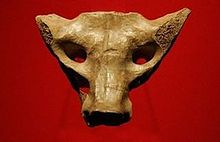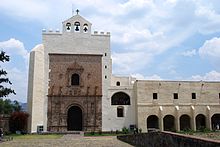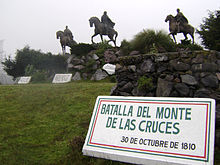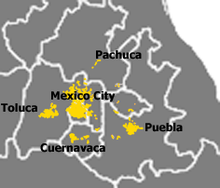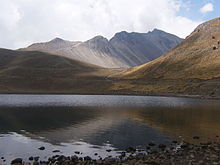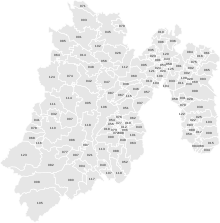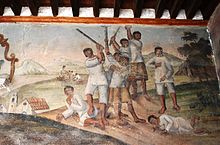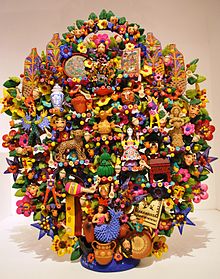- State of Mexico
-
This article is about the state called Mexico within the country of the same name. For the country, see Mexico. For the federal district, see Mexico City. For the divisions of Mexico known as states, see States of Mexico. For other uses, see Mexico (disambiguation).
México
Estado Libre y Soberano de México— State — 
Flag
SealMotto: Libertad, Trabajo, Cultura
(Freedom, Work, Culture)Anthem: Himno al Estado de México State of México within Mexico Coordinates: 19°21′15″N 99°37′51″W / 19.35417°N 99.63083°WCoordinates: 19°21′15″N 99°37′51″W / 19.35417°N 99.63083°W Country Mexico Capital Toluca de Lerdo Largest City Ecatepec de Morelos Municipalities 125 Admission December 20, 1823[1] Order 1st Government - Governor Eruviel Ávila Villegas 
- Senators[2] Yeidckol Polevnsky 
Miguel Bautista
Ulises Ramírez
- Deputies[3] Area[4] - Total 22,357 km2 (8,632.1 sq mi) Ranked 25th Highest elevation[5] 5,500 m (18,045 ft) Population (2010)[6] - Total 15,175,862 - Rank 1st - Density 678.8/km2 (1,758.1/sq mi) - Density rank 1st Demonym Mexiquense Time zone CST (UTC−6) - Summer (DST) CDT (UTC−5) Postal code 50-57 Area code ISO 3166 code MX-MEX HDI  0.837 high Ranked 15th
0.837 high Ranked 15thGDP US$ 62,220,803.98[a] Website Official Web Site ^ a. The state's GDP was 796,426,291 pesos in 2008,[7] corresponding to 62,220,803.98 dollars, with a dollar worth 12.80 pesos (value of June 3, 2010).[8] México ([ˈmexiko] (
 listen)), officially: Estado Libre y Soberano de México (English: Free and Sovereign State of México) is one of the 31 states which, with the Federal District, comprise the 32 Federal Entities of the United Mexican States. It is divided in 125 municipalities and its capital city is Toluca de Lerdo.
listen)), officially: Estado Libre y Soberano de México (English: Free and Sovereign State of México) is one of the 31 states which, with the Federal District, comprise the 32 Federal Entities of the United Mexican States. It is divided in 125 municipalities and its capital city is Toluca de Lerdo.The State of Mexico is often abbreviated to "Edomex" from Estado de México in Spanish). It is located in South-Central Mexico. It is bordered by the states of Querétaro and Hidalgo to the north, Morelos and Guerrero to the south, Michoacán to the west, Tlaxcala and Puebla to the east and surrounds the Federal District.
The state’s origins are in the territory of the Aztec Empire, which remained a political division of New Spain during the colonial period. After Independence, Mexico City was chosen as the capital of the new nation, its territory was separated out the state. Years later, parts of the state were broken off to form the states of Hidalgo, Guerrero and Morelos. These territorial separations have left the state with the size and shape it has today, with the Toluca Valley to the west of Mexico City and a panhandle that extends around the north and east of this entity.
The name of the state is simply “México” according to the Political Constitution of the Mexican United States of 1917, but to distinguish from both the city and the country it is most often called “Estado de México.”
Contents
Origin and etymology
Main article: Name of MexicoMēxihco was originally the Nahuatl name for the eponymous Valley of Mexico wherein the cities of the Mexica (the proper name for the Aztec Triple Alliance) were located. As such, the district that became Mexico City was properly known as Mexico-Tenochtitlan in the years shortly before and after Spanish conquest. After the Spanish Conquest, the term México came to be used for Tenochtitlan/Mexico City and all the pre-conquest lands it controlled, including several other aforementioned Mexican states originally incorporated in the boundaries of the México state.
There are two possible origins for the name “Mexico.” The first is that it derives from metztli (moon) and xictla (navel) to mean from the navel of the moon. This comes from the old Aztec idea that the craters on the moon form a rabbit figure with one crater imitating a navel. The other possible origin is that it is derived from “Mextictli” an alternate name for the god Huitzilopochtli.[9]
Anáhuac was the proper term for all territories dominated by the Aztec Empire, from Cem Anáhuac, "the entire earth" or "surrounded by waters" e.g. the waters of Lake Texcoco which were considered to be the center of the Aztec world;[10][11] and as such was proposed as an early name for the entire nation of Mexico prior to independence, to distinguish it from the (preexisting) administrative division of New Spain that became the State of Mexico.[12]
History
Prehistoric to pre-Hispanic period
The earliest evidence of human habitation in current territory of the state is a quartz scraper and obsidian blade found in the Tlapacoya area, which was an island in the former Lake Chalco. They are dated to the Pleistocene era which dates human habitation back to 20,000 years. These first peoples were hunter-gatherers. Stone age implements have been found all over the territory from mammoth bones, to stone tools to human remains. Most have been found in the areas of Los Reyes Acozac, Tizayuca, Tepexpan, San Francisco Mazapa, El Risco and Tequixquiac. Between 20,000 and 5000 BCE, the people here eventually went from hunting and gathering to sedimentary villages with farming and domesticated animals. The main crop was corn, and stone tools for the grinding of this grain become common. Later crops include beans, chili peppers and squash grown near established villages. Evidence of ceramics appears around 2500 BCE with the earliest artifacts of these appearing in Tlapacoya, Atoto, Malinalco, Acatzingo and Tlatilco.[13]
In prehistoric State of Mexico, the Tepexpan Man is an important finding for Mexcian and foreign anthropologists; it is an important key to understand what was the Valley of Mexico area like, 5000 years ago, as well as helping establish the occupation chronology of the region. Currently some scholars attribute an age of 11 thousand years, others 8 thousand, and some have suggested 5 thousand years old. This individual, originally identified as a male, recent research confirm a female identity, although this is still subject of discussion.[14]
Sacrum bone found in Tequixquiac is considered a work of prehistoric art. The town was inhabited in 35,000 BCE by primitive men who had crossed the Bering Strait from Asia. These people were nomadic, hunting large animals such as mammoths and gathering fruits as evidenced by archaeological evidence found at the site. One of the most salient discoveries of primitive art in America was found in here, called the Tequixquiac Bone,[15][14] which had no known purpose, but reflected the ideological sense of the artist who carved the piece of bone from a camelid around 22,000 years BCE. The first native settlers of Tequixquiac were the Aztecs and Otomi, who decided to settle here permanently for the abundance of rivers and springs. They were engaged mainly in agriculture and the breeding of domestic animals.[16]
The earliest major civilization of the state is Teotihuacan, with the Pyramids of the Sun and Moon being built between 100 BCE and 100 CE. Between 800 and 900 CE, the Matlatzincas established their dominion with Teotenango as capital. This city is walled with plazas, terraces, temples, altars, living quarters and a Mesoamerican ball game court.In the 15th century, the Aztecs conquered the Toluca and Chalco valleys to the west and east of the Valley of Mexico respectively. Part of the Toluca Valley was held by the P’urhépechas as well. Other dominions during the pre-Hispanic period include that of the Chichimecas in Tenayuca and of the Acolhuas in Huexotla, Texcotizingo and Los Melones. Other important groups were the Mazahuas in the Atlacomulco area. Their center was at Mazahuacán, next to Jocotitlán mountain. The Otomis were centered in Jilotepec.[13]
Colonial period
The origin of the modern state is the reorganization of Aztec lands starting after the Spanish Conquest of the Aztec Empire. These lands were initially called the “audencia” of Mexico and included Mexico City, much of modern states of Guerrero, Morelos and Hidalgo. As the Spanish expanded their control west and south, the entirety was called “New Spain” with former Aztec lands being called “Mexico.” The organization of New Spain would change over the course of the colonial period, but the territory of the Aztecs would keep the name “Mexico”.[9][13]
After the Conquest in 1521, Hernán Cortés’ cousin Juan Altamirano was given dominion of the Toluca Valley. Other conquistadors such as Antonio Caicedo, Juan de Jaramillo, Cristobal Hernandez and Juan de Samano received encomiendas in the state. Franciscan missionaries came soon after such as Martin de Valencia, Juan de Tecto, Juan de Ahora, and Pedro de Gante, who established missions and the first school called San Antonio de Padua.[13]
In 1535, the areas around Mexico City were divided into a number of “alcaldías mayors” called Chalco y Ameca, Tlayacapan y Coatepec, Otumba, Ecatepec, Sultepec, Zacualpan, Temascaltepec, Malinalco, Metepec and Ixtlahuaca with Toluca and Texcoco recognized as cities. Other orders followed such as the Dominicans, the Augustinians and the Jesuits.[13]
During the colonial period, most of the area’s economy was based on agriculture with some mining in the areas of Temascaltepec, Sultepec, Valle de Bravo, Tlatlaya, Amatepec and Zacualpan and the production of pulque in Otumba and Texcoco. In addition certain areas were known for crafts such as wool processing in Texcoco and Sultepec, soap in Toluca, saddles in Almoloya de Juárez, and rebozos in various areas. However, the vast majority of the area’s population was extremely poor due to exploitation.[13]
Independence
During the Mexican War of Independence, Miguel Hidalgo y Costilla marched into what is now Mexico State from Michoacán in 1810, passing from the northwest to Toluca on his way to Mexico City. East of Toluca, he fought royalist forces at the Battle of Monte de las Cruces on 30 October 1810.. While Hidalgo won the battle, he chose not to proceed to Mexico City and then turned towards Celaya. During the rest of the War, most battles were fought between local insurgent leaders such as Manuel de la Concha and Castillo Bustamante and royalist forces. Battles were fought in Sultepec, Amanalco, Temascaltepec, Lerma, Tenango, Tenancingo and Tecualoya.[13]
After the War, the State of Mexico was created by the 1824 Constitution, with the first state congress convening in March of that year in Mexico City. This state still encompassed the vast territory of the old Aztec Empire. The first head of the state was Melchor Múzquiz. The vast territory of the state was divided into eight districts:Acapulco, Cuernavaca, Huejutla, México, Taxco, Toluca, Tula and Tulancingo. Mexico City was the capital of the state.[13] However, soon after, the federal government choose Mexico City as the capital of the new nation. Under the guidelines of the 1824 Constitution, the capital was appropriated as federal land, with the federal government acting as the local authority. The choice was made official on 18 November 1824 and Congress delineated a surface area of two leagues square (8,800 ac) centered on the Zocalo. This area was then separated from the State of Mexico, forcing the state's government to move from the Palace of the Inquisition (now Museum of Mexican Medicine) in the city to Texcoco. This area did not yet include the population centers of the towns of Coyoacán, Xochimilco, Mexicaltzingo and Tlalpan, all of which remained as part of the State of Mexico. As the “federal district” of Mexico City grew in size, these and other territories were taken from the State of Mexico.[17] The capital of the state was moved permanently to Toluca in 1830.[18]
The struggles between the liberals (federalists) and the conservatives (centralized power) in the 19th century affected the state, especially in those areas which would later break away to from the states of Hidalgo, Morelos and Guerrero. During the Mexican-American War, the Americans occupied Toluca and Mexico City with the state government temporarily located in the unoccupied Sultepec.[13]
By 1852, the state had lost a significant amount of territory to the creation of the state of Guerrero, which promoted the reorganization of the municipalities here. During the Reform War, General José María Cobos took and sacked a number of municipalities in the territory remaining. During this war, a number of major figures such as Melchor Ocampo, Santos Delgollado and Leandro Valle were executed by firing squad in the Toluca Valley regions.[13]
In 1869, the areas north east and south of Mexico City were converted to the states of Hidalgo and Morelos respectively. The state promulgated a new constitution in 1869, which established the state as consisting of the districts of Chalco, Cuautitlan, Ixtlahuaca, Jilotepec, Lerma, Otumba, Sultepec, Temascaltepec, Tenango del Valle, Tenancingo and Texcoco, which is the territory the state has today.[13] The period before the Mexican Revolution was relatively prosperous for the state, especially under governor José Vicente Villada, who promoted public education, government reform, the establishment of a teachers’ college for women and promoted the Instituto Cientifico y Literario (later UAEM). Mines in various parts of the state were at maximum production.[13]
Mexican Revolution to present
Battles were fought in the state during the Mexican Revolution, especially by Zapatistas in the southwest part of the state, with Genovevo de la O and Francisco de Pacheco entering with their armies in 1912. Fighting intensified after Victoriano Huerta took power in 1913. In 1915, Toluca was the site of the Convencion de Generales y Gobernadores Revolucionaries (Convention of Generals and Revolutionary Governors) on two occasions. In 1917, the state had another new constitution, which divided the state into sixteen districts and 118 municipalities.[13]
The extension of the Mexico City Metropolitan area began in 1940 with the creation of the industrial zone of Naucalpan. The increase of the metro area’s population, commerce and industry has continued to this day.The Consejo del Area Metropolitana was created in 1988 to coordinate concerns and action of the Greater Mexico City area in both the Distrito Federal and the State of Mexico.[13]
From 1824 to 1941, the state had no seal. Governor Wenceslao Labra proposed one in 1940, which was adopted the following year. It was designed by Pastor Velázquez with the motto of “Patria, Libertad, Trabajo y Cultura” (Country, Liberty, Work and Culture).[18]
In 1956, the Instituto Cientifico y Literario was converted into the Universidad Autónoma del Estado de México.[13]
During much of rest of the 20th century, works to divert water from the Lerma River and other locations to Mexico City were built as well as highways through the state to connect Mexico City with the rest of the country.[13]
In 1990, the Commission Coordinadora para la Recuperación Ecológica de la Cuenca del Alto Lerma (Coordinating Commission for the Ecological Recuperation of the Upper Lerma River Basin) was established.[13]
Geography, climate and nature
The state is located in the center of the country, consisting mostly of the eastern side of the Anahuác Mesa. Most of the state consists of the Toluca Valley, with the eastern panhandle mostly defined by the Chalco Valley. The state has a territory of 22,499.95km2 and borders the states of Querétaro, Hidalgo, Guerrero, Morelos, Puebla, Tlaxcala and Michoacán. The state surrounds the Federal District of Mexico City on three sides (west, north and east).[19]
The state is divided into five natural regions: the Volcanos of the Valley of Mexico, the hills and plains north of the state, the western mountains, the Balsas Depression and the mountains and valleys of the southeast.[20]
The natural geography of the state varies. The eastern portion is dominated by the Sierra Nevada, which divides the state from Puebla. In this mountain chain are the Popocatépetl and Iztaccíhuatl volcanos. The Sierra de Monte Alto and Sierra de Monte Bajo divide the west side of the Federal District from the state and contain peaks such as Cerro de la Bufa and Monte de las Cruces. The Sierra de Xinantécatl is to the south of the Toluca Valley. At northern edge of this mountain range is the Nevado de Toluca volcano. In the northwest of the state is the Sierra de San Andrés Timilpan. Most of the rock and soil formation in the state is of volcanic origin.[19]
There are three river basins in the state: the Lerma, the Balsas and the Pánuco. The most important is the Lerma River, which begins in the municipality of Almoloya del Río and passes through a large number of municipalities in the state. The southwestern part of the state is dominated by the Balsas River basin. The eastern panhandle of the state is dominated by the Pánuco River basin. On the various rivers of the state are dams such as José Antonio Alzate in Temoaya, Ignacio Ramirez in Almoloya, Guadalupe in Cuautitlán Izcalli, Madín in Naucalpan, Vicente Guerrero in Tlatlaya, Tepetitlan in San Felipe del Progreso as well as those in Valle del Bravo and Villa Victoria.[19]
Lakes in the state include the Laguna del Sol and Laguna de la Luna in the Nevado de Toluca, the lake in the crater of the Cerro Gorde. Atexcapan Lake in Valle de Bravo, San Simón Lake in Donato Guerra, San Pedro Lake and Concepcion de los Baños Lake and Tepetitlan Lake in San Felipe del Progreso, Acuitzilapan Lake at the food of Jocotitlan Mountain, El Rodeo Lake near Xonacatlán, Xibojay and Santa Elena Lakes in Jilotepec and Huapango Lake in Timilpan.[19]
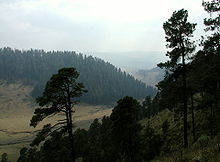 Forest in the La Marquesa National Park.
Forest in the La Marquesa National Park.
About seventy percent of the state has a temperate moist climate, which consists of the highlands of the Toluca Valley and the areas around Texcoco in the north, the Toluca Valley and the areas around Texcoco. Average year-round temperature varies between 12C and 18C with annual precipitation above 700 millimeters. Higher elevations, about 13% of the state, in the center and east of the state have a semicold climate with average temperatures below 16C. Hotter climes are in the relative lowlands in the south west with have an average temperature of between 18C and 22C and constitute about eight percent of the territory. The hottest regions occupy five percent of the state in the extreme southwest with temperatures averaging over 22C. The coldest areas in the highest elevations such as the Nevado de Toluca, Popocatepetl and Iztaccihuatl. Snow can be found on these elevations year round. There are some arid areas along the borders of Hidalgo and Tlaxcala with annual precipitation between 500 and 700 milliliters.[19][21]
Due to the various climates, the state has a wide variety of flora. 609,000 hectares is covered in tree, most of which is in the temperate and cold climates of the state. In the extreme southwest of the state, rainforests can be found and desert plants in the Hidalgo border area. In the highest altitudes, such as the peak of the Nevada de Toluca, alpine grassland can be found. In the extreme west, there are forests which receive thousands of monarch butterflies each winter.[19]
The state has 49 environmentally protected areas, with the most important being the Nevado de Toluca National Park. Other important areas include the state parks of Otomi-Mazahua, Sierra Morelos and Nahuatlaca-Matlatzinca. The Bonsencheve National Park extends into Mexico State from Michoacán, and is one of the major monarch butterfly sanctuaries. At the far east is the Iztaccihual-Popocatepetl National Park which is shared with neighboring Puebla state.[19]
Politics
Main article: Municipalities of Mexico StateThe state is divided into 125 municipalities, which are group into seven regions: Region I Toluca, Region II Zumpango, Region IIITexcoco, Region IV Tejupilco, Region V Atlacomulco, Region VI Coatepec Harinas, Region VII Valle de Bravo and Region VIII Jilotepec.[22] There are two metropolitan areas; the first is Greater Mexico City, in which are 27 municipalities and the six municipalities associated with the city of Toluca.[20]
Demographics
The state contains about thirteen percent of the country’s population and is one of the most densely populated with 520 people per square km. Most of the population growth has come from the expansion of Greater Mexico City outside the borders of the Federal District and into the state, especially since 1970. 85% of the population lives in urban centers, and 39% were born in other parts of Mexico.[23]
Five ethnicities are native to the state: the Mazahua, the Otomi, the Nahuas, the Matlazincas and the Ocuitecos or Tlahuicas. There are also communities of Mixtecs, Zapotecs, Totonaca, Mazateca, Mixe, P’urépecha and Maya. According to the 2005 census, the state has 312,319 people who speak an indigenous language,[23] which is about 3 out of every 100 people. Two thirds of those speaking an indigenous language also speak Spanish.[24]
Education
The state has over three million students who attend about 15,000 schools from kindergarten to high school. It is the largest school system in the country after that of Mexico City. However, as late as 1990, here were over half a million people who were illiterate over the age of 15.[25]
The state university is the Universidad Autónoma del Estado de Mexico which offers 48 majors. This and other institutes of higher education have an enrollment of over 100,000 students.[25] The beginnings of this institution go back to 1828, when the first Instituto Literario for the state was established in what is now the borough of Tlalpan in Mexico City. It was reestablished in Toluca in 1833. In 1886, the name was changed to the Instituto Cientifico y Literario. In 1943, the institution gained autonomy from direct state control and in 1956, it was reorganized ias the UAEM. In 1964, the Ciudad Universitaria on the west side of Toluca was constructed.[26]
Another important public university is the Universidad Autónoma de Chapingo, located in Texcoco. It is an agricultural college offering technical and bachelor’s degrees.[27] The school began as the Escuela Nacional de Agricultura (National School of Agriculture) which was founded in 1854 at the Monastery of San Jacinto in Mexico City. The school was moved in 1923 to the ex Hacienda of Chapingo President Álvaro Obregón.[28][29] One distinguishing feature of the campus is the mural done in the old chapel, now University Ceremonies Room by Diego Rivera called “Tierra Fecundada” (Fertile Land). It is considered to be one of Rivera’s best works.[29][30] More recently, the school acquired an unnamed mural by Luis Nishizawa. This work depicts the agriculture of Mexico in both the past and the present. It is placed in a building that is commonly called “El Partenon”.[31] Other important educational institutions include the Universidad Technológica del Sur del Estado de Mexico [1] and a campus of the ITESM [2].
Infrastructure
The state contains 9,723 km of highways with about 90% being state and 10% federal. There are 1227.4 km of rail line and two airports, “Lic. Adolfo López Mateos” in Toluca and “Dr. Jorge Jiménez Cantú” in Atizapán de Zaragoza. Helicopter facilities exist in Chimalhuacán and Jocotitlán .[25]
The Ferrocarriles Suburbanos is a commuter rail line that connects downtown Mexico City with northern Mexico State municipalities. Service began operations in 2008 with the Buenavista Lechería line. The Buenavista-Cuauhtitlan line was inaugurated in 2009, bringing the total rail ine to 27 km serving communities such as Tultitlán, San Rafael, Tlanepantla and others.[32]
The state contains 23 radio stations, 29 television station ( 2 local and 27 affiliates). The state sponsors two stations called “Radio Mexiquense” and “Televisión Mexiquense”.[25]
Economy
The state provides 9.7% of the country’s gross national product,[24] with over 12% of all of Mexico’s active workforce employed in the state.[33] The most important sector of the economy is industry and manufacturing, with over 10% of the state’s land urbanized.[19][33] The State of Mexico ranks second in the country for industrial output. The most important industries include chemicals, food products, textiles, paper products, metalworks and the construction and maintenance of transport vehicles.[33] This sector employs the highest percentage of the population at 27.7%.[34]
The next largest employer is commerce at 21.5%.[34] One important segment of this sector is this hotel and restaurant industry.[33][34] Outside of the metropolitan areas, tourism is an important element in the state economy, with attractions such as Valle de Bravo, Teotihuacan, Ixtapan de la Sal and others.[33]
Most of the state’s land is devoted to agriculture (38.1%) or to forest (34.9%). Much of these crop forest lands are ejido or communal lands.[19][33] The main crop is corn, with peas, barley, beans, potatoes, alfalfa, wheat, avocados and guava also grown.[21][33] Livestock is raised on about 17% of the state’s farmland with cattle being the most important animal. Almost all of the forest lands in the state are used for producing forestry products such as wood and paper.[33] However, this sector only employs 1.3% of the state’s population.[34]
Other sectors of the economy include financial services, employing 21.4% of the population and transportation which employs 14.4%.[34] While mining has been historically important, today it is only a minor activity despite residual deposits of gold, silver, lead and other minerals.[33]
Attractions
Archeological sites
Main archeological sites include Teotihuacan, Malinalco, Teotenango and Calixtlahuaca. The best known and most important of these is the massive Mesoamerican Teotihuacan, with thousands visiting it each year.[35][36] This city predates the Aztecs and the Toltecs, and is distinguished by two large pyramids, the Pyramid of the Sun and the Pyramid of the Moon.[36]
In Malinalco, the archeological site is officially called the Cuauhtinchan Archeological Zone but it is more commonly called the Cerro de los Idolos.[37] The site is located on a cliff overlooking the town. The visible complex dates from the Aztec Empire but the site’s use as a ceremonial center appears to be much older.[38] The main building served as a sanctuary for Aztec warriors.[39] This complex has been compared to Ellora in India, Petra on the shores of the Dead Sea and Abu Simbel in Egypt.[38]
Teotenango was in important pre-Hispanic fortified city located in the southern part of the Valley of Toluca. It was initially founded during the last stages of the Teotihuacan civilization by a group generally referred to as the “Teotenancas.” Later, the Matlatzincas conquered the city and expanded it.[40][41] The city existed for about 1,000 years, being abandoned only after the Spanish Conquest of the Aztec Empire.[40] In the 15th century, it and the rest of the southern Toluca Valley was conquered by the Aztecs. In the 16th century, the Spanish took over, forced the residents to abandon the old city in favor on a new settlement on the valley floor.[42]
Calixtlahuaca is another Matlazinca site located just outside of the city of Toluca. The site is at least 3,000 years old and shows Teotihuacan, Toltec and Aztec influences. Located on the skirts of the Tenismó mountain, the most outstanding structure is the temple dedicated to Ehécatl, or Quetzalcoatl in his wind god aspect.[43]
Colonial and other historical sites
Most of the state’s colonial attractions are promoted through the “Pueblos con Encanto” program. These include the monasteries and churches located in towns such as de Acolman, Aculco, Amanalco, Amecameca, Ayapango, El Oro, Ixtapan de la Sal, Malinalco, Metepec, Otumba, Temascalcingo, San Juan Teotihuacán, Tlalmanalco, Tonatico and Villa del Carbón.[44] Other colonial structures can be found in Ozumba, Toluca and the cities that surround Mexico City.[35]
The state has twenty six museums and 543 libraries dependent on the Instituto Mexiquense de Cultura. Major institutions include the Centro Cultural Mexiquense and the Notary Archive, the Executive and Legislative Archives in Toluca.[35]
Natural attractions
The natural feature most closely associated with the state is the Nevado de Toluca or Xinantécatl volcano which is just south of the capital of Toluca. This is an extinct volcano which rises 4,690 masl, making it the fourth highest peak in Mexico. At the top is a very large crater that contains two lakes called the Laguna del Sol and the Laguna de la Luna. The volcano and its immediate surroundings are part of the Nevado de Toluca National Park and the Los Venado National Park.[35][36]
Valle de Bravo along with neighboring Lake Avandaro is a major weekend getaway for many in Mexico City and Mexico State. The town is filled with red tile roofs and stone paved streets and has been named a “Pueblo Magico” by the federal tourism agency. The lake is a result of the damming of a regional river and is home to more than forty nautical clubs.[36]
The Grutas de la Estrella is located in the far south of the state on the border with Guerrero. It is a series of live caves in which running water creates formations, some of which are called “The Mammoth,” the “Bride and Groom,” “The Hand” and “The Palace.” They have lighting and other infrastructure as well as guided tours.[36]
Most of the other natural attractions are situated on water sources.Ixtapan de la Sal and Tonatico are noted for their hot-water springs and water parks.[35] Ixtapan de la Sal has attracted the construction of spas and water parks.[36] Tonatico has the fifty-meter high El Salto Waterfall.[35] The Lagunas de Zempoala (Zempoala Lakes) are located on the Santiago Tianguistenco-Cuernavaca highway. The area has forest and cabins. The Isla de la Aves (Island of the Birds) is located in a lake in the municipalities of Atlacolmulco and Timilpan and has an aviary.[35]
Others
To honor the native peoples of the area, there are the Centro Ceremonial Otomi in Temoaya and the Centro Ceremonial Mazahua in San Felipe del Progreso. Both of these have museums, auditoriums, handcrafts centers as well as large forested areas for camping and hiking.[35] Both were built to honor and preserve these indigenous cultures.[36]
Zacango is the state’s major zoo with over 2,000 species from all over the world.[35] It is located fourteen km from the city of Toluca in the municipality of Calimaya. It is one of the few zoos in Mexico where all the animals live in natural-like enclosures.[45]
The Cosmovitral is a stained glass mural and botanical garden located in Toluca. The building takes its name from the murals which are set in the buildings huge windows that surround the building and in the ceiling. The building originally was construction in 1910 as the 16 de Septiembre Market, but when this was closed in 1975, Leopoldo Flores successfully convinced the city government to convert the building into a space for art. The Cosmovitral is located on the corner of Juárez and Lerdo de Tejada streets in the downtown.[46] The best known aspect of t his work is the “Hombre Sol” or Sun Man. Each year on the spring equinox, the sun aligns with this panel of the stained glass work. This image has become one of the symbols of the state.[47]
Culture
Ceramics have been made in the Toluca Valley region since far into the pre-Hispanic period, mostly by Matlatzincas and Nahuas. The tradition continued into the colonial period although it much changed in both technique and design. Today both manufactured and handcrafted ceramics are produced in the state. The most traditional handcrafted wares are produced in places such as Metepec, Valle de Bravo, Texcoco and Almoloya de Juárez among others. The best known pottery and ceramics locale is Metepec, which specializes in large decorative pieces and sculptures called Trees of Life. Cooking utensils are made as well.[48]
Objects made from precious metals such as silver are a specialty of the Mazahua people of the Toluca Valley. One specialty is jewelry and other decorative objects made with fine silver or gold wire. One community associated with this work is San Felipe del Progreso, where both wire and hammered items are made. Other communities of metalworkers exist in Naucalpan and Cuidad Nezahualcóyotl. In addition to jewelry, items such as bells, sculpture religious paraphernalia and more can be found.[49]
Waxworks is dedicated mostly to the making of decorative and aromatic candles. These range from the simple to elaborately carved samples. These are mostluy made in Amecameca, Tenango del Valle and Toluca.[50]
The making of piñatas, decorative cut outs and other objects from paper and/or cardboard is known in Acolman, Metepec, Toluca, Huixquilucan, Nezahualcoyotl and Otumba. This tradition dates back to pre-Hispanic times with bark paper, but newer materials have been incorporated since then. For example, paper cut out banner or papel picado was originally done with crepe paper (called “papel chino” in Spanish) but today it can be seen done on thin plastic sheets.[51]
The making of fireworks is best known in Tultepec in the municipality of Lerma. Not only are firecrackers and rockets made, but elaborate contraptions with firecrackers place to moves the parts when lit are made as well. These can be called “castillos” (castles) or “toritos” (little bulls) depending on their shape. These are use during religious and secular festivals such as saints’ day and Independence Day.[52] Tultepec holds a fireworks festival each year.[53]
Other crafts practiced in the state include the making of candies, basketry, artistic ironwork, and items from bone, horn, stone and wood.[54]
Traditional dances performed in the state include the Danza de los Concheros, Danza de Moros y Cristianos, Doce Pares de Francia, Morisma and Santiagos. One particular to Mexico State is the El Tzimare-cu, which is performed by the Otomi communities in Xonacatlán, Villa Cuauhtemoc and Temoaya.[35]
The state is known for its red and black moles, the barbacoa of Capulhuac and Tenango del Valle, the chorizo sausage of Toluca and the cheese products of Ayapango and Aculco. Beverages include pulque and “tecui.”[35]
Major festivals and fairs in the state include the Feria de San Isidro Labrador, an agricultural fair in Metepec, the Festival de la Quimera, a cultural fair in Metepec, the Feria Internacional del Caballo horse fair in Texcoco, the Feria de la Nuez (Nut Fair) in Amecameca, the Festival de las Almas and Fiests de San Francisco de Asis in Valle de Bravo and the Feria de Alfeñique, which sells candies and other traditional goods for Day of the Dead.[53]
The Orquesta Sinfónica del Estado de México or Mexico State Symphonic Orchestra was established in 1971 by Enrique Bátez Cambell. It is based in Toluca in the Felipe Villanueva Hall. It has given performances in various parts of both the state and nation of Mexico. It has made more recordings than any other state orchestra in the country, and in the 2000s it made its first appearances outside of Mexico in the United States and Europe.[55]
Major communities
- Chalco
- Chimalhuacán
- Ciudad López Mateos (Atizapán de Zaragoza)
- Ciudad Nezahualcóyotl
- Cuautitlán Izcalli
- Ecatepec de Morelos
- Huixquilucan
- Ixtapaluca
- Los Reyes Acaquilpan (Los Reyes La Paz)
- Naucalpan (Naucalpan de Juárez)
- San Francisco Coacalco
- Tlalnepantla (Tlalnepantla de Baz)
- Toluca (Toluca de Lerdo)
- Valle de Bravo
- Villa Nicolás Romero
- Xico
See also
References
- ^ "Las Diputaciones Provinciales" (in Spanish). p. 15. http://biblio.juridicas.unam.mx/libros/6/2920/11.pdf.
- ^ "Senadores por el Estado de Mexico LXI Legislatura". Senado de la Republica. http://www.senado.gob.mx/index.php?ver=int&mn=4&sm=4&id=16. Retrieved March 24, 2010.
- ^ "Listado de Diputados por Grupo Parlamentario del Estado de Jalisco". Camara de Diputados. http://sitl.diputados.gob.mx/LXI_leg/listado_diputados_gpnp.php?tipot=Edo&edot=14. Retrieved March 24, 2010.
- ^ "Resumen". Cuentame INEGI. http://cuentame.inegi.gob.mx/monografias/informacion/mex/default.aspx?tema=me&e=15. Retrieved March 24, 2011.
- ^ "Relieve". Cuentame INEGI. http://cuentame.inegi.gob.mx/monografias/informacion/mex/territorio/relieve.aspx?tema=me&e=15. Retrieved March 24, 2011.
- ^ "Mexico en Cifras". INEGI. http://www.inegi.org.mx/sistemas/mexicocifras/default.aspx?ent=15. Retrieved March 24, 2011.
- ^ "Estado de Mexico.". 2010. http://www.inegi.org.mx/sistemas/mexicocifras/default.aspx?ent=15. Retrieved March 24, 2011.
- ^ "Reporte: Jueves 3 de Junio del 2010. Cierre del peso mexicano.". www.pesomexicano.com.mx. http://www.pesomexicano.com.mx/archivo/2010/junio/03/reporte-jueves-3-de-junio-del-2010--cierre-del-peso-mexicano.htm#leermas. Retrieved August 10, 2010.
- ^ a b "Origen y fundación del Estado de México [Origin and foundation of the State of Mexico]" (in Spanish). Club Planeta. http://www.elclima.com.mx/origen_y_fundacion_del_estado_de_mexico.htm. Retrieved July 8, 2010.
- ^ A Nahuatl Interpretation of the Conquest
- ^ Universidad Anáhuac
- ^ ¿Puede ser libre la Nueva España?
- ^ a b c d e f g h i j k l m n o p q "Historia [History]" (in Spanish). Enciclopedia de los Municipios de México. Mexico: Instituto Nacional para el Federalismo y el Desarrollo Municipal. 2005. http://www.e-local.gob.mx/work/templates/enciclo/mexico/. Retrieved July 8, 2010.[dead link]
- ^ a b "Estado de Mexico [State of Mexico]" (in Spanish). http://es.wikipedia.org/wiki/Estado_de_M%C3%A9xico#Origen. Retrieved Nov. 2010.
- ^ "Rescate del pasado [Rescue of the past]" (in Spanish). Deporte.org.com. http://www.deporte.org.mx/biblioteca/M68/Disco1/libro/capitulo_2.pdf. Retrieved Sept. 2010.
- ^ "Tequixquiac". English Wikipedia. http://en.wikipedia.org/wiki/Tequixquiac. Retrieved Sept. 2010.
- ^ Alvarez, Jose Rogelio (2003). "Distrito Federal" (in Spanish). Enciclopedia de Mexico. IV. Sabeco International Investment Corp.. pp. 2293–2314. ISBN 1-56409-063-9.
- ^ a b "nomenclatura [State of Mexico]" (in Spanish). Enciclopedia de los Municipios de México. Mexico: Instituto Nacional para el Federalismo y el Desarrollo Municipal. 2005. http://www.e-local.gob.mx/work/templates/enciclo/mexico/. Retrieved July 8, 2010.[dead link]
- ^ a b c d e f g h i "Medio Fisico [Environment]" (in Spanish). Enciclopedia de los Municipios de México. Mexico: Instituto Nacional para el Federalismo y el Desarrollo Municipal. 2005. http://www.e-local.gob.mx/work/templates/enciclo/mexico/. Retrieved July 8, 2010.[dead link]
- ^ a b "Regionalización [Regions]" (in Spanish). Enciclopedia de los Municipios de México. Mexico: Instituto Nacional para el Federalismo y el Desarrollo Municipal. 2005. http://www.e-local.gob.mx/work/templates/enciclo/mexico/. Retrieved July 8, 2010.[dead link]
- ^ a b "Clima [Climate]" (in Spanish). INEGI. http://cuentame.inegi.gob.mx/monografias/informacion/mex/territorio/clima.aspx?tema=me&e=15. Retrieved July 8, 2010.
- ^ "Estado de Mexico [State of Mexico]" (in Spanish). Enciclopedia de los Municipios de México. Mexico: Instituto Nacional para el Federalismo y el Desarrollo Municipal. 2005. http://www.e-local.gob.mx/work/templates/enciclo/mexico/. Retrieved July 8, 2010.[dead link]
- ^ a b "Perfil Sociodemográfico [Sociodemographic Profile]" (in Spanish). Enciclopedia de los Municipios de México. Mexico: Instituto Nacional para el Federalismo y el Desarrollo Municipal. 2005. http://www.e-local.gob.mx/work/templates/enciclo/mexico/. Retrieved July 8, 2010.[dead link]
- ^ a b "Resumen [Summary]" (in Spanish). INEGI. http://cuentame.inegi.gob.mx/monografias/informacion/mex/default.aspx?tema=me&e=15. Retrieved July 8, 2010.
- ^ a b c d "Infraestructura Social y de Comunicaciones2005 [Social Infrastructure and Communications]" (in Spanish). Enciclopedia de los Municipios de México. Mexico: Instituto Nacional para el Federalismo y el Desarrollo Municipal. 2005. http://www.e-local.gob.mx/work/templates/enciclo/mexico/. Retrieved July 8, 2010.[dead link]
- ^ "Génesis de la Universidad [Genesis of the University]" (in Spanish). Toluca: UAEM. http://www.uaemex.mx/ideario/guni/. Retrieved July 8, 2010.
- ^ "Rectoría" (in Spanish). Texcoco, Mexico: Universidad Autonoma de Chapingo. http://portal.chapingo.mx/rectoria/?modulo=universidad. Retrieved 2010-02-16.
- ^ "Historia" (in Spanish). Texcoco, Mexico: Universidad Autonoma de Chapingo. http://portal.chapingo.mx/rectoria/?modulo=historia. Retrieved 2010-02-16.
- ^ a b Novo, Gerardo; Jorge de la Luz (2002). The State of Mexico. Madrid: Ediciones Nueva Guia SA de CV. p. 140. ISBN 968 5437 26 2.
- ^ "Ciudad / Atractivos turísticos y culturales [City: Tourist and cultural attractions]" (in Spanish). Texcoco, Mexico: Municipality of Texcoco. http://www.texcoco.gob.mx/ciudad_atractivos_culturales_economicos. Retrieved 2010-02-16.
- ^ Avalos, Leopoldo (2006-02-16). "Llevan mural a Chapingo [Bringing mural to Chapingo]" (in Spanish). Reforma (Mexico City): p. 14.
- ^ "Tren Suburbano de la Zona Metropolitana del Valle de México [Suburban Train of the Metropolitan Area of the Valley of Mexico]" (in Spanish). http://www.estadodemexico.com.mx/especiales.item.6/tren-suburbano-de-la-zona-metropolitana-del-valle-de-mexico.html. Retrieved July 8, 2010.
- ^ a b c d e f g h i "Actividad Economica [Economic Activity]" (in Spanish). Enciclopedia de los Municipios de México. Mexico: Instituto Nacional para el Federalismo y el Desarrollo Municipal. 2005. http://www.e-local.gob.mx/work/templates/enciclo/mexico/. Retrieved July 8, 2010.[dead link]
- ^ a b c d e "Actividades económicas [Economic activities]" (in Spanish). INEGI. http://cuentame.inegi.gob.mx/monografias/informacion/mex/economia/default.aspx?tema=me&e=15. Retrieved July 8, 2010.
- ^ a b c d e f g h i j k "Atractivos Culturales y Turísticos [Cultural and Tourist Attractions]" (in Spanish). Enciclopedia de los Municipios de México. Mexico: Instituto Nacional para el Federalismo y el Desarrollo Municipal. 2005. http://www.e-local.gob.mx/work/templates/enciclo/mexico/. Retrieved July 8, 2010.[dead link]
- ^ a b c d e f g "Sitios para Turistas en Estado de México [Sites for Tourists in the State of Mexico]" (in Spanish). Explorando Mexico. http://www.explorandomexico.com.mx/state/14/Estado-de-Mexico/attractions/. Retrieved July 8, 2010.
- ^ "Malinalco “Guerreros de una Sola Pieza”" (in Spanish). INAFED. http://www.inafed.gob.mx/wb2/municipios/15052_Turismo. Retrieved 2009-10-29.[dead link]
- ^ a b Novo, Gerardo; Jorge de la Luz (2002). The State of Mexico. Mexico City: Ediciones Nueva Guia SA de CV. pp. 49–53. ISBN 968 5437 26 2.
- ^ Noguez, Xavier (2006). "El templo monolítico de Malinalco, Estado de México [The monolithic temple of Malinalco, Mexico State]" (in Spanish). Arqueología Mexicana 78: 68–73. http://www.arqueomex.com/S2N3nMalinalco78.html. Retrieved 2009-10-29.
- ^ a b "Teotenango (Tenango del Valle)" (in Spanish). Mexico State: Estado de México. http://www.edomexico.gob.mx/imc/teotenango.html. Retrieved 2 August 2009.
- ^ Hernandez A., Tania. 2008-11-16 "Irregularidades en la protección de la zona arqueológica de Teotenango" (in Spanish). Mexico City: Milenio. http://impreso.milenio.com/node/7002705 2008-11-16. Retrieved 2 August 2009.
- ^ (in Spanish) Teotenango:La Antigua Ciudad Amurallada, Guia de la Zona Arqueologica [Teotenango:The Walled City]. Toluca: Instituto Mexiqunse de Cultura.
- ^ "Calixtlahuaca (Estado de México) [Calixtlahuaca (Mexico State)]" (in Spanish). Mexico City: Mexico Desconocido magazine. http://www.mexicodesconocido.com.mx/notas/2886-Calixtlahuaca-%28Estado-de-M%E9xico%29. Retrieved July 8, 2010.
- ^ "Pueblos con encanto del Bicentenario [Towns with Charm of the Bicentennial]" (in Spanish). Mexico: State of Mexico. http://qacontent.edomex.gob.mx/edomex/temas/turismo/pueblos_bicentenario/index.htm?ssSourceNodeId=1931&ssSourceSiteId=edomex. Retrieved July 8, 2010.
- ^ "Zoologico de Zacango [Zacango Zoo]" (in Spanish). Mexico City: Turi Mexico. http://www.turimexico.com/edomex/zacango.php. Retrieved July 8, 2010.
- ^ INEGI (1997). Estado de México Guía Turística]. INEGI. ISBN 970-13-1194-9.
- ^ Espinosa, Arturo (2008-03-23). "Destella el Hombre Sol [The Sun Man stands out]" (in Spanish). Reforma (Mexico City): p. 8.
- ^ IIFAEM (2009). "Alfarería y Cerámica [Pottery and Ceramics]" (in Spanish). Mexico: State of Mexico. http://qacontent.edomex.gob.mx/edomex/temas/turismo/artesanias/alfareria_ceramica/index.htm. Retrieved July 8, 2010.
- ^ IIFAEM (2009). "Orfebrería y Joyería [Precious metals and jewelry]" (in Spanish). Mexico: State of Mexico. http://qacontent.edomex.gob.mx/edomex/temas/turismo/artesanias/orfebreria_joyeria/index.htm. Retrieved July 8, 2010.
- ^ IIFAEM (2009). htm "Cerería [Wax work]" (in Spanish). Mexico: State of Mexico. http://qacontent.edomex.gob.mx/edomex/temas/turismo/artesanias/cereria/index.htm htm. Retrieved July 8, 2010.
- ^ IIFAEM (2009). "Papelería y cartonería [Crafts from paper and cardboard]" (in Spanish). Mexico: State of Mexico. http://qacontent.edomex.gob.mx/edomex/temas/turismo/artesanias/papeleria_cartoneria/index.htm. Retrieved July 8, 2010.
- ^ IIFAEM (2009). "Pirotécnia [Pyrotechnics]" (in Spanish). Mexico: State of Mexico. http://qacontent.edomex.gob.mx/edomex/temas/turismo/artesanias/pirotecnia/index.htm. Retrieved July 8, 2010.
- ^ a b "Fiestas en el estado de México [Festivals in the State of Mexico]" (in Spanish). Club Planeta. http://www.elclima.com.mx/fiestas_en_el_estado_de_mexico.htm. Retrieved July 8, 2010.
- ^ "Artesanías del estado de México [Crafts of the State of Mexico]" (in Spanish). Mexico: State of Mexico. 2009. http://qacontent.edomex.gob.mx/edomex/temas/turismo/artesanias/index.htm?ssSourceNodeId=1931&ssSourceSiteId=edomex. Retrieved July 8, 2010.
- ^ "Orquesta Sinfónica del Estado de Mexico/Semblanza [Symphonic Orchestra of the State of Mexico/Ensamble]" (in Spanish). Mexico: State of Mexico. http://web.edomexico.gob.mx/portal/page/portal/osem/la-orquesta. Retrieved July 8, 2010.
 This article incorporates text from a publication now in the public domain: Chisholm, Hugh, ed (1911). Encyclopædia Britannica (11th ed.). Cambridge University Press.
This article incorporates text from a publication now in the public domain: Chisholm, Hugh, ed (1911). Encyclopædia Britannica (11th ed.). Cambridge University Press.External links
 State of Mexico
State of MexicoToluca (capital) Municipalities Acambay · Acolman de Nezahualcóyotl · Aculco · Almoloya de Alquisiras · Almoloya de Juárez · Almoloya del Río · Amanalco · Amatepec · Amecameca · Apaxco · San Salvador Atenco · Santa Cruz Atizapán · Ciudad López Mateos · Atlacomulco · Atlautla · Axapusco · Ayapango · Buenavista · Calimaya · Capulhuac · Chalco de Díaz Covarrubias · Chapa de Mota · Chapultepec · Chiautla · Chicoloapan · Chiconcuac · Chimalhuacán · Coacalco de Berriozábal · Coatepec Harinas · Cocotitlán · Coyotepec · Cuautitlán · Cuautitlán Izcalli · Donato Guerra · Ecatepec de Morelos · Ecatzingo · El Oro · Huehuetoca · Hueypoxtla · Huixquilucan · Ixtapaluca · Ixtapan de la Sal · Ixtapan del Oro · Ixtlahuaca · Jaltenco · Jilotepec · Jilotzingo · Jiquipilco · Jocotitlán · Joquicingo · Juchitepec · Los Reyes Acaquilpan · Lerma · Luvianos · Malinalco · Melchor Ocampo · Metepec · Mexicaltzingo · Morelos · Naucalpan · Nextlalpan · Nezahualcóyotl · Ciudad Nicolás Romero · Nopaltepec · Ocoyoacac · Ocuilán · Otumba · Otzoloapan · Otzolotepec · Ozumba · Papalotla · Polotitlán · San Antonio la Isla · San Felipe del Progreso · San Martín de las Pirámides · San Mateo Atenco · San Simón de Guerrero · Santo Tomás de los Plátanos · Soyaniquilpan · Sultepec · Tecámac · Tejupilco · Temamatla · Temascalapa · Temascalcingo · Temascaltepec · Temoaya · Tenancingo de Degollado · Tenango del Aire · Tenango del Valle · Teoloyucan · Teotihuacán de Arista · Tepetlaoxtoc · Tepetlixpa · Tepotzotlán · Tequixquiac · Texcaltitlán · Texcalyacac · Texcoco de Mora · Tezoyuca · Tianguistenco · Timilpan · Tlalmanalco · Tlalnepantla · Tlatlaya · Toluca · Tonatico · Tonanitla · Tultepec · Tultitlán · Valle de Bravo · Xico · Villa de Allende · Villa del Carbón · Villa Guerrero · Villa Victoria · Xalatlaco · Xonacatlán · Zacazonapan · Zacualpan · Zinacantepec · Zumpahuacán · Zumpango

States of Mexico States Aguascalientes · Baja California · Baja California Sur · Campeche · Chiapas · Chihuahua · Coahuila · Colima · Durango · Guanajuato · Guerrero · Hidalgo · Jalisco · México · Michoacán · Morelos · Nayarit · Nuevo León · Oaxaca · Puebla · Querétaro · Quintana Roo · San Luis Potosí · Sinaloa · Sonora · Tabasco · Tamaulipas · Tlaxcala · Veracruz · Yucatán · Zacatecas

Federal District Categories:- States of Mexico
- State of Mexico
- States and territories established in 1823
Wikimedia Foundation. 2010.


